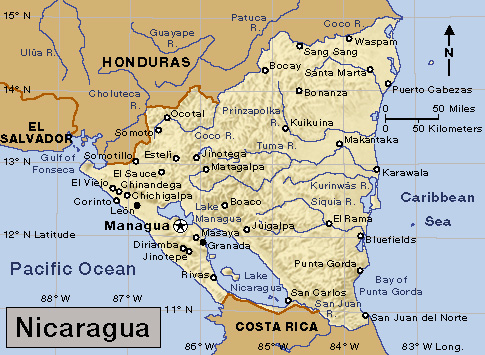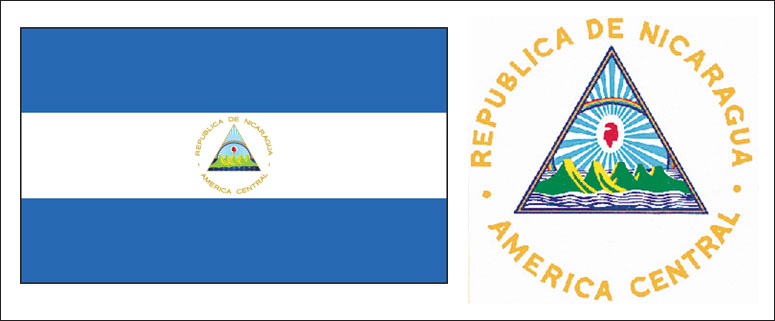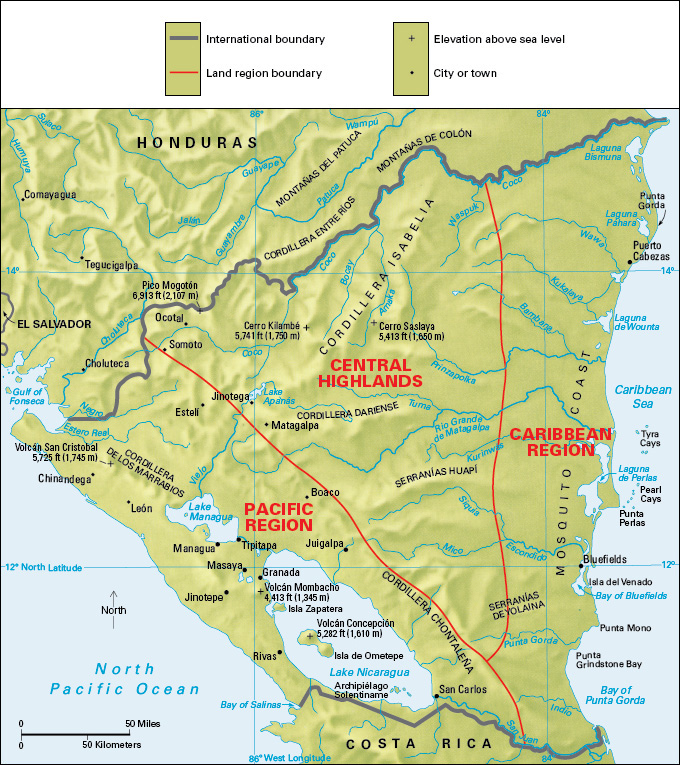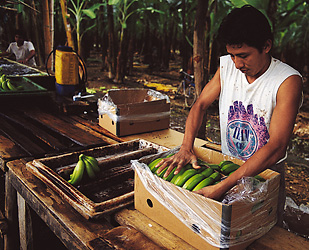Nicaragua, << `nihk` uh RAH gwuh, >> is the largest country of Central America in area. It extends from the Pacific Ocean to the Caribbean Sea. About three-fifths of the country’s people live in a fertile region on the Pacific side. In this region is Managua, the capital and largest city of Nicaragua.

Most Nicaraguans have both Indigenous (native) and Spanish ancestors. During the early 1500’s, the Spaniards began arriving in what is now Nicaragua. They named the land for an Indigenous chief and his tribe, both called Nicarao, who lived there. The Nicarao way of life, like that of most other Indigenous peoples of Nicaragua, has blended with Spanish customs and traditions. Today, Nicaragua has only a few Indigenous groups that follow their traditional way of life.
Coffee is one of Nicaragua’s leading sources of income. It is grown in the Pacific Region of western Nicaragua and in the Central Highlands. Few people live in the thickly forested Caribbean Region in the eastern part of the country.
Government
A president heads the national government of Nicaragua. The people elect the president and a vice president to five-year terms. The president appoints a Cabinet to help carry out the day-to-day operations of the government. The National Assembly makes the country’s laws. The people elect 90 members of the Assembly to five-year terms. After each election, the outgoing president and the presidential candidate who came in second also receive Assembly seats. All Nicaraguans 16 years of age and older may vote in elections.

Nicaragua is divided into 15 departments and 2 autonomous (self-governing) regions on the Atlantic coast. The country is further divided into municipalities for purposes of local government. The people elect a mayor and a council to administer each municipality.
Nicaragua has a number of political parties, which often form alliances. Two major parties are the Sandinista National Liberation Front (FSLN), commonly called the Sandinistas, and the Liberal Constitutionalist Party (PLC).
The Supreme Court of Justice is Nicaragua’s highest court. It hears appeals from lower courts. It has 16 judges. The judges are elected by the National Assembly to five-year terms.
The armed forces of Nicaragua consist of an air force, army, and navy. Service is voluntary.
People
The majority of Nicaraguans are mestizos (people with both Spanish and Indigenous ancestors). About half of Nicaraguans belong to the Roman Catholic Church. Most Nicaraguans speak Spanish. The only Indigenous groups in Nicaragua that still speak their own languages and follow their traditional ways of life live in the thinly populated Caribbean Region. This region also has several communities of Black people, and of Black and Indigenous people, that largely follow Indigenous customs and traditions.
About two-fifths of Nicaraguans are poor people who farm for a living. Many of those in the Pacific Region are peasants who work on their own farms, on cooperatives or state farms, or on large private farms. In warmer areas, agricultural workers live in palm- or metal-roofed houses. In the colder areas of the Central Highlands, farmers live in adobe houses with tile roofs. The Black and Indigenous people of the Caribbean Region live chiefly by farming small plots or by fishing, lumbering, or mining.
Nicaraguan law requires children to go to school from the age of 6 through 12. Before 1980, only about half of Nicaraguan children did so. Most of these children lived in cities or towns. Nicaragua had too few schools. Many rural areas had no schools at all. But since then, the government has built hundreds of rural schools. The government also conducted a successful literacy campaign. The campaign is headed mainly by young volunteer teachers.
Nicaragua has several universities. The National Autonomous University of Nicaragua, in Managua and León, is the oldest and largest university. It was founded in 1812.
The land and climate
Nicaragua has three main land regions, the Pacific Region, the Central Highlands, and the Caribbean Region. The climate is chiefly tropical, with some differences among these regions.
The Pacific Region
is largely a low area extending from Honduras to Costa Rica. Several volcanoes are in this low area. Some of the volcanoes are active. Lake Managua and Lake Nicaragua lie in the central and southern sections. Mountains up to 3,000 feet (910 meters) high rise along the Pacific coast. Nicaragua’s largest cities and many large farms are in the Pacific Region.

The region receives about 60 inches (150 centimeters) of rain a year. The rainy season lasts from May to November. Temperatures average about 80 °F (27 °C) throughout the year.
The Central Highlands
make up Nicaragua’s highest and coolest region. They include the country’s highest point, Pico Mogoton. This peak on the border with Honduras north of Ocotal rises 6,913 ft. (2,107 m) above sea level. Forests cover most of the region’s slopes. Deep valleys lie between the mountains.
Some areas receive over 100 inches (250 centimeters) of rain a year. Most people live on farms in drier areas. Like the Pacific Region, the Central Highlands have a rainy season from May to November. Temperatures average 60 to 70 °F (16 to 21 °C).

The Caribbean Region
is mostly a flat plain. The region also has some highlands sloping upward toward the west. Many rivers that rise in the Central Highlands flow through the plain. The region’s only good farmland lies along the riverbanks. Rain forests cover most of the region. There are grasslands with palm and pine forests in the north. A number of small islands lie off the coast.
Easterly trade winds drench the Caribbean Region with an annual average of 165 inches (419 centimeters) of rain. The rain falls throughout most of the year. Temperatures in the region average 80 °F (27 °C).
Economy
Nicaragua is one of the poorest countries in Latin America. Remittances (money sent home) from Nicaraguans living abroad is important to the economy. Nicaragua’s economy also relies on foreign aid.

Nicaragua’s major natural resource is the rich soil of the Pacific Region. Ash from volcanoes makes this soil fertile. Farming is a leading economic activity. Nicaragua has some deposits of copper, gold, and silver. However, mining provides only a small part of the nation’s income. Nicaragua has no oil reserves, and the country must import oil to meet its needs. Thick forests cover much of the land.
Agriculture
is one of the leading economic activities in Nicaragua. About one-third of the country’s workers are involved in raising crops and livestock. Farming activities center in the Central Highlands and the Pacific Region. Farm products provide much of Nicaragua’s export income. The country’s leading crops include bananas, beans, cassava, coffee, corn, peanuts, rice, sugar cane, and tobacco. Farmers also raise cattle for meat and milk and chickens for eggs and meat. 
Manufacturing
is an important part of Nicaragua’s economy. Nicaragua’s industry is concentrated in Managua. Most of the nation’s electric power is generated there. As in most Central American countries, the major products of industry are processed foods and beverages, clothing, and textiles. Other products include cement, machinery, and petroleum.
Service industries
employ about half of Nicaragua’s workers and account for about half of Nicaragua’s gross domestic product (GDP). The GDP is the total value of goods and services produced within a country in a year. Wholesale and retail trade form the leading service industry in Nicaragua. The marketing of farm products is an important type of trade.
Foreign trade.
Nicaragua imports more than it exports. The country imports electronics, machinery, motor vehicles, petroleum and petroleum products, and pharmaceuticals (medicinal drugs). Leading exports include beef, coffee, clothing, gold, lobster, peanuts, shrimp, and sugar. The United States is Nicaragua’s chief trading partner. Important Latin American trading partners include Costa Rica, El Salvador, Guatemala, Honduras, and Mexico. Nicaragua belongs to the Central American Common Market, an economic union of nations.
Transportation.
Nicaragua’s road system is in poor condition. Most of the country’s roads are unpaved. The Pan American Highway is the country’s major highway (see Pan American Highway). This highway runs through the western part of Nicaragua. Many populated areas cannot be reached by automobile. The people in these areas use mules or oxcarts. Few Nicaraguans own an automobile. Bluefields, Corinto, and Puerto Sandino have major seaports. Managua has an international airport.
Communication.
Nicaragua has few newspapers. The largest are La Prensa and El Nuevo Diario, both of Managua. Radio and TV stations are the leading sources of information.
History
The Indigenous period.
Little is known of what is now Nicaragua before the Spaniards arrived in the early 1500’s. A series of Indigenous states occupied the Pacific Region and the Central Highlands. They built fortified towns. They had highly developed markets and a system of social classes that included enslaved people. Less developed Indigenous societies lived in the Caribbean Region.
The colonial period.
In 1502, Christopher Columbus arrived at what is now Nicaragua. He claimed the land for Spain. A Spanish expedition from Panama explored the Pacific Region in 1522. Many of the Nicarao people who lived in the region were baptized as Roman Catholics.
Another expedition from Panama arrived in 1524. The leader was Francisco Fernández de Córdoba. He founded Granada and León near the main sources of Indigenous labor. Indigenous people worked on the Spaniards’ farms and in their mines. In 1570, Nicaragua came under the control of the Audiencia of Guatemala. The Audiencia was a high court of Spanish judges and administrators that ruled most of Central America. Nicaragua was part of the colony of New Spain. But the court had great power because Nicaragua was so far from Mexico City, the colonial capital.
The Spaniards explored the Caribbean coast of Nicaragua but did not settle there. During the 1600’s and 1700’s, other Europeans—chiefly the English—occupied that region from time to time. English, Dutch, and French pirates had hideouts there. They attacked Spanish shipping in the Caribbean Sea. The pirates also raided Spanish towns to the west. During the 1700’s, the English gained control over the Indigenous Miskito (also called Mosquito) people of the Caribbean coast. The United Kingdom gave up its hold on the region to Nicaragua in the mid-1800’s.
Independence.
On Sept. 15, 1821, Nicaragua and other Central American states declared their independence. These states later became part of the Mexican Empire. They broke away from the empire in 1823 and established the United Provinces of Central America. In general, this union followed liberal economic and political policies. For example, the member states established various civil rights. In addition they also ended the special rights of powerful nobles and the Roman Catholic Church.
The union began to collapse under various pressures. Divisive pressures included efforts by the conservative landowners and the clergy to regain their old privileges. In 1838, Nicaragua left the union. By then, a dispute had developed between León, the liberal center, and Granada, the conservative center. These two cities struggled for control of Nicaragua. Fighting often broke out.
The liberals of León asked William Walker, an American military adventurer, to help them. In 1855, Walker arrived with a band of followers. He captured Granada in a surprise attack. But instead of helping the liberals, he seized control of the government in 1856. The next year, the liberals and conservatives joined forces. Together, they drove Walker from the country.
The United States and Nicaragua.
For many years, the United States had wanted to build a canal across Nicaragua to link the Atlantic and Pacific oceans. In 1901, President José Santos Zelaya of Nicaragua set certain limits on U.S. rights in the proposed Nicaragua Canal zone. The United States did not accept these limits. Instead, it shifted its attention to Panama as the site of the canal. Zelaya then threatened to sell rights to the canal to some rival country of the United States. He also canceled contracts with a number of U.S. firms.
In 1909, a revolt broke out against Zelaya, a harsh ruler. He was driven from office after the United States sided with the rebels. In 1911, U.S. banks began to lend money to Nicaragua under agreements that gave them control over its finances until the debts were paid in 1925. At the request of the banks and President Adolfo Diaz, U.S. marines landed in Nicaragua in 1912 to put down forces opposed to American control. The marines remained in Nicaragua almost continuously until 1933 to protect United States interests and supervise elections.
Rebels led by General Augusto César Sandino tried to make the U.S. forces leave Nicaragua. From 1927 to 1933, the rebels raided the U.S. marines from hideouts in the mountains. The United States trained a new Nicaraguan army, called the National Guard, to help the marines. Anastasio Somoza García became head of the National Guard. In 1934, after the marines had left, Somoza had members of the National Guard murder Sandino.
The Somoza period.
In 1936, Somoza forced President Juan Sacasa to resign. Somoza, who was Sacasa’s nephew, became president the next year after an election in which he was the only candidate. Somoza grabbed political and economic power for himself and his family. He ruled as a dictator.
From 1937 until 1979, a Somoza ruled Nicaragua either as president or as the real power behind the government. Anastasio Somoza was assassinated in 1956. His older son, Luis, then replaced him as president. Luis held the presidency until 1963. His brother, Anastasio Somoza Debayle, became president in 1967. In general, the Somozas were eager to cooperate with the United States. They had support from the U.S. government.
Political stability under the Somoza family rule attracted U.S. investments. Nicaragua’s economy expanded. The 160-mile (257-kilometer) Rama Road was built between 1968 and 1980 with U.S. aid. It helped connect the Pacific and Caribbean coasts of Nicaragua.
In 1972, an earthquake in Nicaragua killed about 5,000 people. It destroyed much of Managua. The city was rebuilt near the site of the earthquake. Also in 1972, President Anastasio Somoza Debayle turned over formal power to a civilian junta. A junta is a small group that takes over a government and rules by decree. However, he continued to rule from behind the scenes as head of the National Guard. In 1974, Somoza was elected president for six years.
Rebel victory.
Widespread protests against Somoza’s rule began in the mid-1970’s. Protesters demanded Somoza’s removal from office. Many of the opponents belonged to the Sandinista National Liberation Front, then a guerrilla group. The group was named after Augusto César Sandino. Many other political and economic groups joined the Sandinistas’ protests.
By 1978, the conflict between the rebels and the government had become a civil war. The rebels won the war in1979. They forced President Somoza to resign and leave the country. They then set up a new government. In 1980, Somoza was assassinated in Paraguay.
The late 1900’s.
The new Sandinista government, led by Daniel Ortega, took over key parts of the economy. It controlled agricultural exports, banking, insurance, and mining. But the economic system was a mixture of public and private ownership. The government adopted many policies designed to help the poor. It worked to improve the economy, which had been badly damaged in the civil war. But economic recovery from the war was slow. Hardships remained for many people.
In the early 1980’s, internal opposition to the Sandinistas developed. The opponents disputed Sandinista economic policy and the type of government to be established. In 1981, the United States charged that Nicaragua was providing weapons to rebels in other Central American countries. It cut off aid to Nicaragua. In that year, former members of Somoza’s National Guard and others stepped up attacks from bases in Honduras. In response, the Nicaraguan government declared a state of emergency. Nicaragua launched a campaign to build up its military forces. In 1983, several thousand anti-Sandinistas invaded northeastern Nicaragua. Fighting broke out between the invaders, called contras, and government forces. The fighting caused many deaths from 1983 to 1990. The United States gave financial aid to the contras. The Soviet Union, Cuba, Western European nations, and other countries aided the Sandinista government.
Ortega was elected president of Nicaragua in 1984. United States President Ronald Reagan charged that the Sandinistas had set up a Communist dictatorship. He also said that the Sandinistas were providing aid to rebels in other Central American countries. In late 1983 and early 1984, the United States helped the contras place mines in Nicaraguan harbors. In 1985, Reagan ordered an embargo on U.S. trade with Nicaragua. Before the embargo, the United States had been Nicaragua’s chief trading partner.
Some people in the United States opposed U.S. financial aid to the contras. In the 1980’s, the U.S. Congress voted sometimes for and sometimes against further aid to the rebels. In 1986, the International Court of Justice concluded that the United States had acted illegally in helping the contras. United States officials rejected the conclusion.
In March 1988, the Sandinistas and the contras negotiated a cease-fire. They held talks to try to resolve their differences. Although no peace agreement was reached, fighting declined following the talks. But fighting resumed after the government refused to extend the cease-fire past Oct. 31, 1989.
In February 1990, Violeta Barrios de Chamorro of the anti-Sandinista National Opposition Union (UNO) was elected president. The government and the contras signed a cease-fire agreement in April. By June, the contra troops had been disbanded.
After Chamorro’s election, the United States ended its trade embargo against Nicaragua. During the 1990’s, the government began to privatize some areas of the economy. But Nicaragua still faced severe economic problems, including high inflation and poor industrial performance.
José Arnoldo Alemán Lacayo of the rightist Liberal Alliance won a presidential election in 1996. The main party in the Liberal Alliance was the Liberal Constitutionalist Party (PLC).
In 1998, Hurricane Mitch struck Nicaragua, resulting in floods and landslides. The storm killed about 3,000 people and caused more than $1 billion in damage.
The early 2000’s.
Enrique Bolanos Geyer of the PLC was elected president in 2001. Former president Daniel Ortega was reelected in 2006 and took office in 2007. Despite presidential term limits, Ortega ran again for president in 2011 and won. In 2014, Nicaragua’s legislature amended the Constitution to eliminate presidential term limits. Ortega was reelected in 2016.
Public protests erupted in 2018 against changes to Nicaragua’s social security system. Government efforts to suppress (put down) the protests led to domestic and international criticism and to calls for Ortega’s resignation. Hundreds of people were killed, and hundreds more were imprisoned.
Ortega was reelected president in 2021. Before the election, the government arrested and detained several other presidential candidates and many of its critics and opponents. Such repressive actions drew condemnation and concern from many Nicaraguans and from democratic governments abroad.
